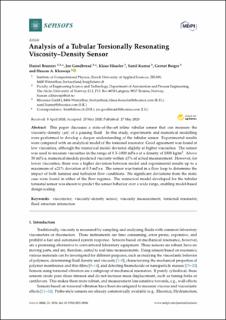Please use this identifier to cite or link to this item:
https://doi.org/10.21256/zhaw-20176| Publication type: | Article in scientific journal |
| Type of review: | Peer review (publication) |
| Title: | Analysis of a tubular torsionally resonating viscosity–density sensor |
| Authors: | Brunner, Daniel Goodbread, Joe Häusler, Klaus Kumar, Sunil Boiger, Gernot Kurt Khawaja, Hassan A. |
| et. al: | No |
| DOI: | 10.3390/s20113036 10.21256/zhaw-20176 |
| Published in: | Sensors |
| Volume(Issue): | 20 |
| Issue: | 11 |
| Page(s): | 3036 |
| Issue Date: | 27-May-2020 |
| Publisher / Ed. Institution: | MDPI |
| ISSN: | 1424-8220 1424-8239 |
| Language: | English |
| Subjects: | Fluid–structure interaction; Torsional resonator; Viscometer; Viscosity measurement; Viscosity–density sensor |
| Subject (DDC): | 530: Physics |
| Abstract: | This paper discusses a state-of-the-art inline tubular sensor that can measure the viscosity-density of a passing fluid. In this study, experiments and numerical modelling were performed to develop a deeper understanding of the tubular sensor. Experimental results were compared with an analytical model of the torsional resonator. Good agreement was found at low viscosities, although the numerical model deviated slightly at higher viscosities. The sensor was used to measure viscosities in the range of 0.3-1000 mPa·s at a density of 1000 kg/m3. Above 50 mPa·s, numerical models predicted viscosity within ±5% of actual measurement. However, for lower viscosities, there was a higher deviation between model and experimental results up to a maximum of ±21% deviation at 0.3 mPa·s. The sensor was tested in a flow loop to determine the impact of both laminar and turbulent flow conditions. No significant deviations from the static case were found in either of the flow regimes. The numerical model developed for the tubular torsional sensor was shown to predict the sensor behavior over a wide range, enabling model-based design scaling. |
| URI: | https://digitalcollection.zhaw.ch/handle/11475/20176 |
| Fulltext version: | Published version |
| License (according to publishing contract): | CC BY 4.0: Attribution 4.0 International |
| Departement: | School of Engineering |
| Organisational Unit: | Institute of Computational Physics (ICP) |
| Appears in collections: | Publikationen School of Engineering |
Files in This Item:
| File | Description | Size | Format | |
|---|---|---|---|---|
| 2020_Brunner_etal_Analysis-viscosity-density-sensor_Sensors.pdf | 1.56 MB | Adobe PDF |  View/Open |
Show full item record
Brunner, D., Goodbread, J., Häusler, K., Kumar, S., Boiger, G. K., & Khawaja, H. A. (2020). Analysis of a tubular torsionally resonating viscosity–density sensor. Sensors, 20(11), 3036. https://doi.org/10.3390/s20113036
Brunner, D. et al. (2020) ‘Analysis of a tubular torsionally resonating viscosity–density sensor’, Sensors, 20(11), p. 3036. Available at: https://doi.org/10.3390/s20113036.
D. Brunner, J. Goodbread, K. Häusler, S. Kumar, G. K. Boiger, and H. A. Khawaja, “Analysis of a tubular torsionally resonating viscosity–density sensor,” Sensors, vol. 20, no. 11, p. 3036, May 2020, doi: 10.3390/s20113036.
BRUNNER, Daniel, Joe GOODBREAD, Klaus HÄUSLER, Sunil KUMAR, Gernot Kurt BOIGER und Hassan A. KHAWAJA, 2020. Analysis of a tubular torsionally resonating viscosity–density sensor. Sensors. 27 Mai 2020. Bd. 20, Nr. 11, S. 3036. DOI 10.3390/s20113036
Brunner, Daniel, Joe Goodbread, Klaus Häusler, Sunil Kumar, Gernot Kurt Boiger, and Hassan A. Khawaja. 2020. “Analysis of a Tubular Torsionally Resonating Viscosity–Density Sensor.” Sensors 20 (11): 3036. https://doi.org/10.3390/s20113036.
Brunner, Daniel, et al. “Analysis of a Tubular Torsionally Resonating Viscosity–Density Sensor.” Sensors, vol. 20, no. 11, May 2020, p. 3036, https://doi.org/10.3390/s20113036.
Items in DSpace are protected by copyright, with all rights reserved, unless otherwise indicated.